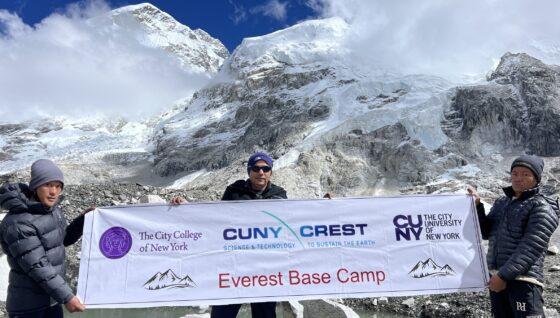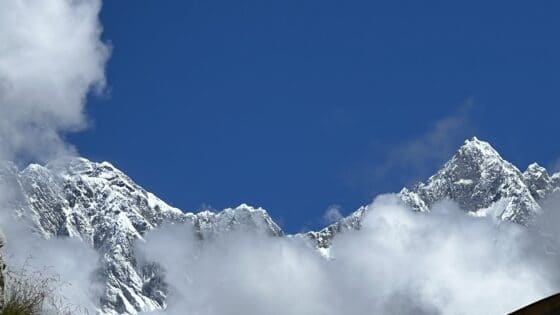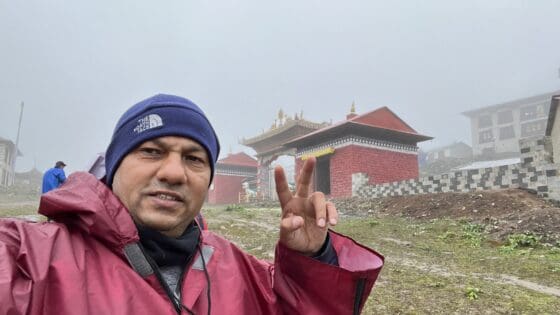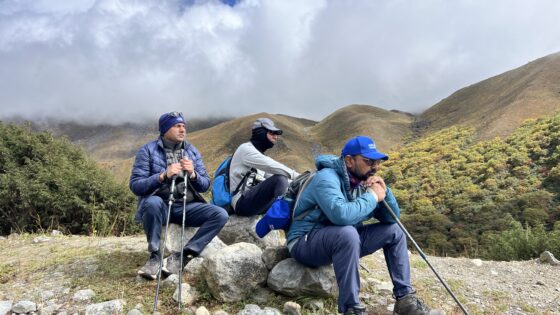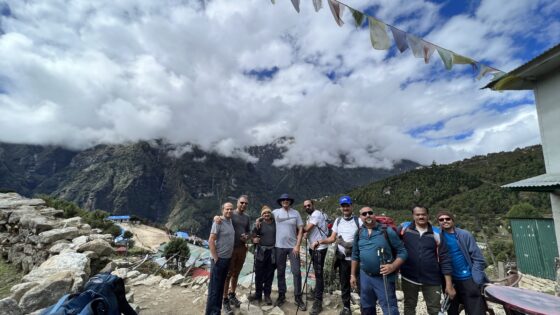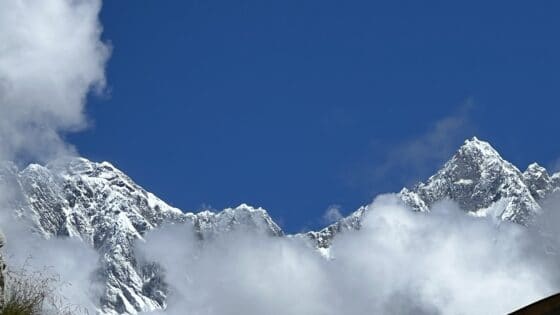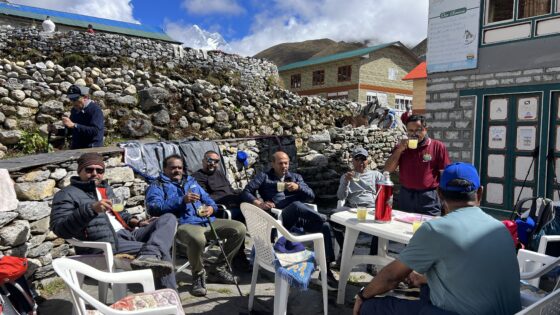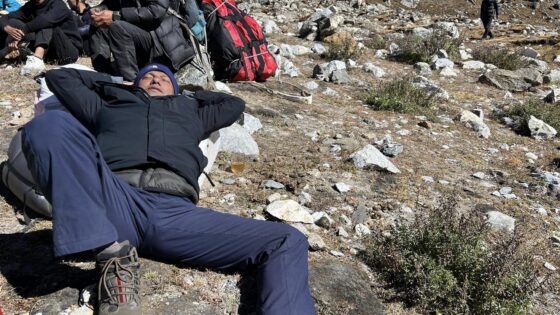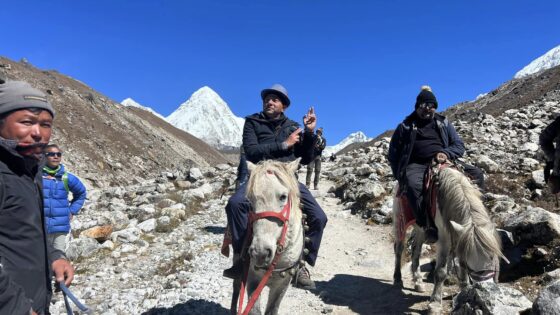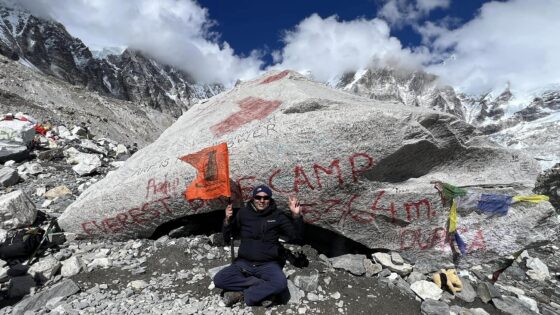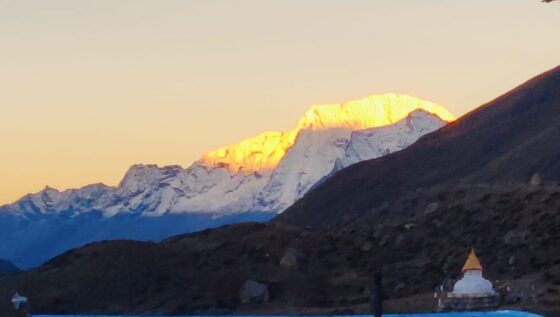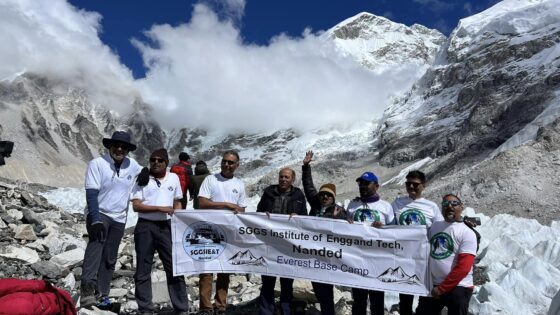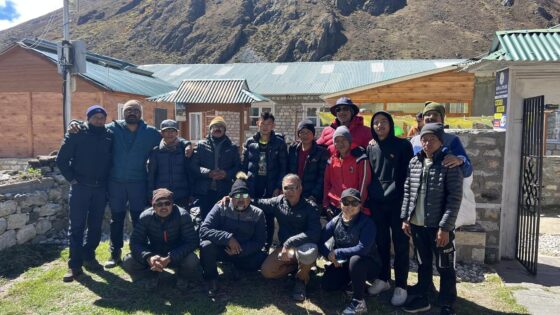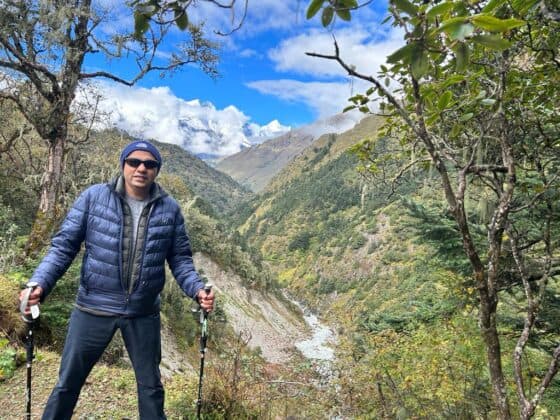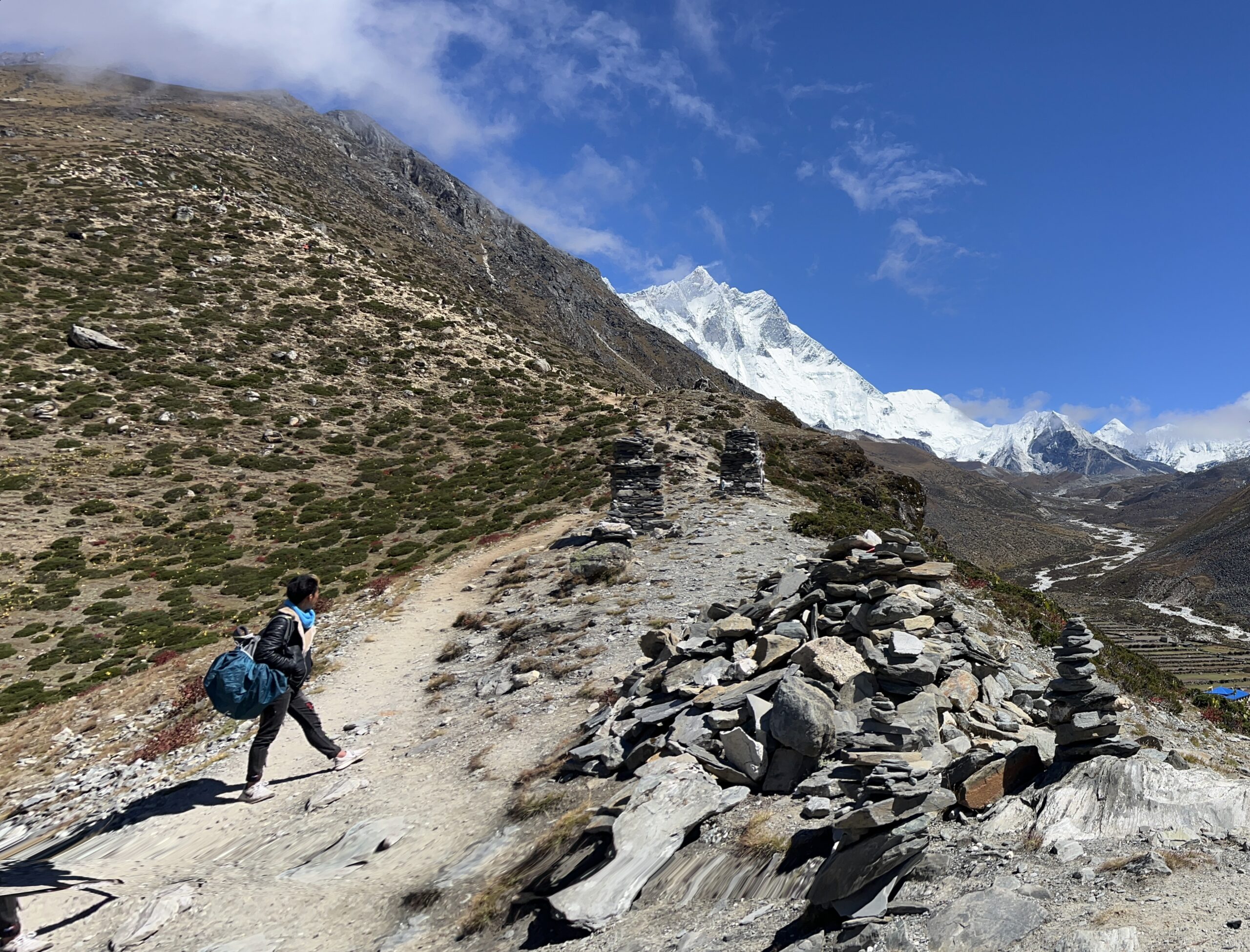Dr. Tarendra Lakhankar, an expert in snow research, recently completed the Everest Base Camp trek at 17,598 feet, enhancing his study of Himalayan glaciers. His primary research in the USA involved developing snow mapping techniques using advanced instruments, contributing to understanding snow signatures in remote sensing. The challenging two-week trek in Nepal, with reduced oxygen levels and physical demands, furthered his commitment to environmental research and provided insights into high-altitude climate conditions. Understanding these glaciers is crucial for gauging climate change impacts on regional water resources. During the trip, Post-Everest, Dr. Lakhankar explored South India’s ancient temples (Madurai, Tanjore, Rameshwaram, Kanchipuram, and Coimbatore), enriching his cultural and historical knowledge. He also engaged in intellectual exchanges at various Indian educational institutes (IIT-BHU, COEP Pune, YCC, and Priyadarshini College of Engineering in Nagpur), sharing insights and experiences.
Tarendra’s Daily Diary of Himalayan Trekking
On 29th September 2023, I arrived at Nagpur airport at 3 am after traveling from America. After reaching home, I rested for the entire day. The next day, on 30th September, I was ready at Nagpur airport at 4 am for the Mount Everest Base Camp Trek. I met three team members in Nagpur, and the rest joined us in Mumbai. We were nine members, all alums of SGGS Engineering College in Nanded.
Our journey was from Nagpur to Kathmandu, the capital of Nepal (elevation 4,344 ft). We took an early morning flight from Nagpur to Mumbai, arriving around 8 am. Then, we caught another flight from Mumbai to Kathmandu at around 11 am, which, due to a delay, departed around 1 pm. We reached Kathmandu around 3 pm, and our trek leader, Dikki, welcomed us. We got to our hotel around 5 pm. The next day, we had another short flight from Kathmandu to Lukla. Lukla (elevation 9,383 ft) is the starting point for treks to Mount Everest Base Camp. Due to the high and rocky mountains, Lukla is inaccessible by road, so the only way to reach there is by small plane or helicopter.
At 8 pm, we learned that all flights between Kathmandu and Lukla were canceled due to sudden bad weather. Flights in the Himalayas, particularly between Lukla and Kathmandu, are irregular due to unpredictable and adverse weather conditions. These weather changes often halt long-range flights.
Only short-distance flights were operational, starting from Rameshep. Since Lukla is often cloudy, flights from Rameshep begin when the clouds clear, reaching Lukla in about 25-30 minutes. It’s the only way to travel in that region.
Dikki and our team decided to take a bus to Rameshep (elevation 3,996 ft). The road to Rameshep is nearly 150 km long and winds through mountainous terrain, where the bus speed is around 25-30 km/h. We started our journey at midnight, and the road was bumpy throughout. Unable to sleep, we all listened to music from the 1990s, reminiscing when we were young. As all team members were around 50 years old, memories of songs from their youth helped alleviate the discomfort of the bumpy roads.
We reached Rameshep at 7 am. Many travelers were waiting for flights to Lukla due to delays. We were lucky to get a flight in the afternoon and came to Lukla in 30 minutes. After a quick meal and rest, we began our first trek from Lukla to Phakding. Dikki had selected some Sherpas to transport our luggage, and an additional co-guide joined us. Everyone was excited. Our trek from Lukla to Mount Everest Base Camp began with enthusiasm. We reached our accommodation in Phakding at 6 pm. Tired from days of travel and lack of sleep, we quickly had a Nepali dinner, discussed plans for the next day, and went to sleep.
On October 2nd, the second day, at 8 am, we began our long ascent from Phakding to Namche Bazaar. As we trekked over slippery peaks and ascended, a heaviness started to set in our bodies. We had to climb those slippery mountains repeatedly. Since most of our energy was depleted, we had to eat something to maintain our energy levels continuously. This was the second day of our trek towards Everest Base Camp, and acclimatizing to the environment was becoming challenging. We reached Namche Bazaar (11,286 ft) around 6 pm. Namche Bazaar is a significant place at the foothills of Mount Everest, where trekkers rest and prepare for the next part of their trek. It is equipped with various shops, restaurants, and lodges.
After reaching the hotel, I vomited all the food I had eaten earlier. Perhaps I had eaten more than necessary, thinking I needed the energy. My body was completely exhausted, and I had no energy left. I even lost the strength to stand. I felt extremely uneasy and went to sleep without having dinner. Trekking to Everest Base Camp is a significant challenge. Doubts crept into my mind about whether I could complete this trek. If my body couldn’t cope, would I have to return? These thoughts haunted me that night, and I slept soundly.
After a night’s rest on the morning of October 3rd, I woke up. The experience of the previous day wasn’t great. The thought of returning briefly crossed my mind. But looking at my goal, I decided to try trekking for one more day. If I couldn’t manage, then I would return. I gave my body another chance. My spirit lifted, and I began climbing again. In Namche Bazaar, everyone did some shopping, including essentials for trekking and things we had forgotten earlier. As you go higher in the mountains, things become more expensive.
In the afternoon, we reached Hotel Everest View (13,000 ft), where we could glimpse Mount Everest’s summit. The beauty of that sight was breathtaking and revitalized the enthusiasm among the team members. Then we trekked downhill towards Khumjung village (12,400 ft) and reached there by 5 pm. I was exhausted and went straight to sleep. After some restless sleep, I woke up at 8 pm feeling feverish. I had some soup, took a Paracetamol, and returned to sleep. The temperature had dropped to zero Celsius. Coming from the controlled temperatures of air conditioning in America and the warm climate of central India, this temperature was extremely low for me. A single quilt was not enough. In this mountainous region, villages are far apart, and there is no electricity grid. Each house has a few solar panels that generate electricity to light their homes.
On October 4th, I woke up in the morning feeling heavy. Suddenly, my back pain resurfaced, perhaps due to the cold. I have experienced back pain intermittently for the past ten years. I wondered how I could continue trekking with this pain. Should I turn around? I had brought heating pads that stayed warm for 8 hours, so I applied one to my back and took another Paracetamol. I told myself, “No stopping now,” and began the fourth day of trekking enthusiastically.
It was a rainy day. The cold wind was now accompanied by rain. We had pre-arranged our night’s stay, so staying in the same place for an extra day wasn’t an option. Everyone had raincoats. The challenge was immense. The question was whether I could endure it. But as they say, when efforts are coupled with prayers, obstacles on the path of struggle can be easily overcome. At that moment, I remembered my mother. With the thought of ‘Mother’s blessings are with me,’ I started climbing. The Paracetamol and heating pad somewhat eased my back pain. Our clothes and boots got wet due to the rain. Walking in such conditions was extremely difficult.
In the afternoon, we took a break for lunch at a small village restaurant and continued on our way as the rain had eased. By 6 pm, we reached Tengboche (12,687 ft). After facing many challenges, the day we turned out to be fulfilling. We spent a pleasant evening with the team members. We had bought a small karaoke system in Lukla, which came in handy as everyone sang and listened to songs, enjoying themselves thoroughly.
On October 5th, the fifth day of our trek, I woke up with a stiff back. I applied painkiller spray and prepared to continue the climb. The morning sun was gentle. The snowy white peaks of Mount Everest were glistening in golden light. I captured this beauty not only with my eyes but also with my camera. The painkiller spray worked. We started our climb with the same vigor on the fifth day. As we climbed higher, predicting the weather became impossible. Sometimes, it was sunny, cloudy, rainy, and occasionally windy. The chill in the air was so intense that the layers of my jacket seemed inadequate. The cold wind was piercing through my coat. Enduring the cold was challenging, and I started to shiver. The oxygen level at that altitude was low, leading to nausea, headaches, and extreme discomfort. I borrowed an extra jacket from my team member Shrikant and wore it. Layering up made me feel like a robot for the remaining 2 km of the journey. Our accommodation was just 10 minutes away, but taking another step felt impossible. Shrikant and Dikki supported me, and somehow, I reached the Dengboche (14,470ft) Tea House. In that region, people refer to these small hotels as ‘Tea Houses.’ I was utterly exhausted, feeling as if life was draining out of my body.
When we arrived at Dengboche (14,470 ft), one of our team members had critically low oxygen levels. He was promptly taken to the hospital on horseback. Dikki took both of us to the hospital. The doctors performed all the preliminary tests on us. They reviewed my basic information and found my condition to be stable. They prescribed me essential medicines like Diamox and vitamins for high altitude. Our team member, whose oxygen level had dropped to 45% and had 60% water in his lungs, was advised to be admitted to the hospital and urgently evacuated to Kathmandu. It was night by then, so Dikki and other team members immediately contacted emergency services and insurance, arranging a helicopter evacuation to Kathmandu the next day.
On October 4th at Dengboche (14,470 ft), the next day was for acclimatization, where we were to trek for about 3-4 hours to a higher elevation and then return for rest. This process helps in acclimatizing to the lower oxygen environment at high altitudes.
On the morning of October 6th, before starting our trek, we bid farewell to our team member, who was evacuated to Kathmandu by helicopter, and we began our high-altitude trek. We had a good meal after returning from the trek around 2 pm. Dikki specifically instructed me not to sleep during the day. Meanwhile, the Tea House had bathing facilities. I paid 800 rupees for a hot water bucket and bathed. Later, we played cards and other games. We all were missing our home-cooked Marathi food. One of our team members asked the chef if we could help him cook in our style. We gave him some tips, and he agreed. Finally, we had a good curry and rice. The meal was delightful. We all had dinner at 7 pm. After dinner, I slept until 7 am the following day. It was the longest rest I had on a bed during the trek. Due to the high altitude and low oxygen, we could not sleep well. Sleep was restless and disturbing.
October 7th was the seventh day. Our target was to trek to Lobuche (16,210 ft), a place of breathtaking natural beauty. We reached Lobuche in the afternoon. We got a small room with three beds. During our free time, we played Satkarmi, had discussions, and had fun with the team members, reducing trekking fatigue and sharing experiences that energized each other. It was freezing. The room in the hotel was so chilly that it felt like the snow was seeping in from outside. There was no basin in the room, and we had to go outside for small needs. The cold water in the washroom was piercing. The fear of freezing was real. We had been going through these conditions for four to five days. But as we moved higher towards the base camp, things became more challenging. The oxygen level becomes rarefied at higher altitudes. In the atmosphere, oxygen levels drop to only about 70%. It’s essential to breathe slowly at this pace. With each step, a breath was taken. Trekking often involves encountering diverse situations.
On October 8th, the trekking week began. We had a little distance left to reach our goal. Today’s goal was to cross Gorak Shep (16,942 ft) and reach Everest Base Camp. The journey was difficult. The distance from Gorak Shep to Everest Base Camp is approximately 12 kilometers. The afternoon weather in this region was terrible, with strong winds and accompanying rain. We started the climb at 5 am and reached Gorak Shep by 9 am. After a quick brunch, we started again. The excitement of getting to the base camp was at its peak. We started the climb again from Gorak Shep around 10 am and reached “Everest Base Camp” at 1 pm.
We were elated at the end of the journey to Everest Base Camp (17,598 ft). Aside from the rest of the team’s times, the celebrations of reaching Everest Base Camp trekking were joyous. Memories of the Everest Base Camp trek were filled with enthusiasm. The view of snow-capped peaks from afar was enchanting, and experiencing the white snowy peaks all around was mesmerizing. Everyone’s face showed excitement and satisfaction. The joy of many moments during the trekking was captured in the camera.
At times, the irresistible urge to capture the beautiful snow peaks of Mount Everest, which we had only seen in photos, overcomes us. The beauty of nature and the desire to have our pictures taken in its presence is quite natural. Unfortunately, there was no mirror in our room for shaving, so we had to shave by asking each other for guidance. We took numerous photos, ensuring we looked our best in each other’s eyes. The beauty of the Everest snow peaks was stored in our eyes, and now it was time to start the descent from the base camp. There was no doubt that the return journey would be challenging. We reached Gorak Shep late at night.
Every morning, I woke up with back pain. To cope, I started using painkiller spray again. Near the end of the trekking, the back pain also gave up and stopped bothering me. Perhaps my body had adapted to the challenges of the climb, or it had become stronger through the physical and mental struggles. At the end of the trekking, I felt I had surpassed my limits of strength and endurance, which was an empowering experience.
On October 9th, we planned to go to Kala Patthar (18,519 ft) early in the morning to see the sunlight falling on Mount Everest and witness its golden color. Everyone was so tired, and unanimously, we canceled the idea of going to Kala Patthar. Some of us were feeling headaches, nausea, and tiredness. After breakfast, we started the return journey to Pheriche (14,340 ft).
We reached Pheriche around noon, which was at a lower elevation. We started feeling better. After going to Pheriche, we learned there was no flight (small plane) service from Lukla to Rameshep. Lukla was under the cloud most of the time in the last few days, with little or no visibility required for helicopters or small planes. We learned that helicopters can fly with less visibility compared to small planes. On the other hand, helicopters carry only four people, while small planes can take around 20-24 people. All helicopters were extremely busy and in high demand. After reaching Pheriche, a few trekkers were waiting for a helicopter to get to Lukla for a couple of days. We were unsure if we would get a helicopter to Lukla from Pheriche on the same day or the next day. That day, we stayed in Pheriche with uncertainty. Thankfully, Pheriche had a nice restaurant and WiFi signals. At least we could pass the time with the internet and social media.
On October 10th, we kept waiting and waiting. In the evening, Dikki brought the good news that we would have a helicopter to take us to Lukla at 3 pm at a higher price. Finally, we got the helicopter, which dropped us off at Lukla, where there was more uncertainty about returning to Kathmandu or even Rameshep. We had a good dinner that night at Lukla. We went to a restaurant with a TV and watched a cricket match. We were without screens (TV or laptop) for the last ten days, the first in 30 years. Wow!
On October 11th, we woke up and saw clouds in the sky, starting to feel disappointed. If the clouds remained in the sky, there would be no plane or helicopter flights. Still, we took our bags and reached Lukla airport, where around 100 people were waiting. Everyone was waiting for the clouds to clear for the flights to resume. Around 11 am, the clouds began to move slightly, and visibility in the sky started improving. We all were hopeful that our wait would soon end and we could return to our homes. The faces at the airport reflected both tension and hope.
An announcement was made that the clouds were less at the nearby Surkey Helipad, which was 5 km away (a 1.5-2 hour walk in the mountainous region), and helicopter service was operational. Dikki immediately arranged for tickets and urged us to move quickly before the clouds returned. Typically, in the afternoon in mountainous regions, clouds form due to a meteorological phenomenon known as “valley wind.” During the day, the sun warms the air in the valleys, and by afternoon, the air rises the slopes of the mountains. We all faced this challenge, quickly heading towards Surkey or running, not wanting to miss that helicopter flight as we had a flight from Kathmandu to Delhi the following day. Surkey Helipad is just a flat land area, approximately 50 meters x 50 meters in size.
At Surkey Helipad, over 100 people were already waiting. In the entire country of Nepal, there are only about 26-35 helicopters, including operational and grounded ones. Therefore, the demand for helicopters is very high. After waiting 3 hours, we got a helicopter service to Rameshep, which was also double the price we initially expected. Finally, with the helicopter, we reached Rameshep, where we had another long 6-7 hour journey by a small bus to Kathmandu on a bumpy road. But we were happy, as we felt better at this lower elevation with normal oxygen levels. By 10 pm, we finally reached Kathmandu. After settling all expenses, we slept in a regular bed in a good hotel with an AC room.
On October 12th, after waking up, we packed our bags and decided to visit the famous Pashupatinath Temple in Nepal on the way to the airport. We thanked God for all the adventures and for bringing us back safely. The grand visit to Pashupatinath Temple and its peaceful atmosphere brought more tranquility and joy to our minds. We spent some time in the temple compound, experiencing the divine presence and offering prayers. After that, we headed to the airport. This concluded our remarkable and memorable adventurous journey with the visit to Pashupatinath Temple.
@ 2021 All Rights Reserved www.lakhankar.com

